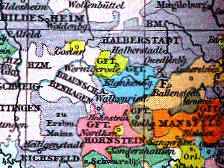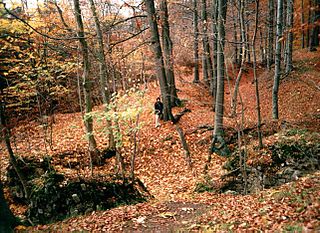The ruins of Wolfsberg Castle (German : Burgruine Wolfsberg) lie on an eminence in the municipality of Wolfsberg in the German state of Saxony-Anhalt. Of the once extensive mediaeval castle only a few foundation remnants survive.
The ruins of Wolfsberg Castle (German : Burgruine Wolfsberg) lie on an eminence in the municipality of Wolfsberg in the German state of Saxony-Anhalt. Of the once extensive mediaeval castle only a few foundation remnants survive.
It is believed that Wolfsberg Castle, like its southeastern neighbour, Questenberg Castle, was built by the counts of Beichlingen-Rothenburg around the year 1300. Around 1309, it entered into the possession of the counts of Anhalt-Bernburg, who enfeoffed the castle. The new lords of the castle (Burgherren) were hostile towards their neighbours, the counts of Stolberg, and raided their estates. In 1320, after a legal decision in his favour, Count Henry of Stolberg took the law into his own hands and captured Wolfsberg Castle. In order to protect the estate from the claims of the House of Anhalt, he transferred it as a fief to Bishop Albert of Halberstadt and was officially enfeoffed with it on 18 December 1325 along with Erichsberg Castle.
At the end of 1326, Wolfsberg Castle was used as an expiatory object in the conflict over the castles of Ebersberg and Erichsberg. In later years, it was enfeoffed several times by the counts of Stolberg, but always with the option of being redeemed. Wolfsberg and Erichsberg remained fiefs of the Bishopric of Halberstadt.
The castle was damaged during the Peasants' War of 1525, but even prior to that it had become run down, because in 1511 repairs to its roof and walls were carried out at the behest of the comital Vogt of Stolberg, Volkmar of Morungen. From a report by the Wolfsberg Amtmann , Michel Sultzpach, to Count Wolfgang of Stolberg in 1549, it is understood that Haus Wolfsberg, together with its barns and livestock sheds, was rebuilt for 2,000 guilders. This leaves open the question as to whether it was referring to the castle or the manor of the estate of Wolfsberg which was built in 1524.
Wolfsberg was enfeoffed several times even in the early modern period, but finally fell into ruins in the 18th century for lack of maintenance.

Wernigerode is a town in the district of Harz, Saxony-Anhalt, Germany. Until 2007, it was the capital of the district of Wernigerode. Its population was 32,181 in 2020.

Ilsenburg Abbey was a monastery of the Benedictine Order located at Ilsenburg near Wernigerode, in Saxony-Anhalt in Germany. The former abbey is a stop on the Romanesque Road.

Blankenburg (Harz) is a town and health resort in the district of Harz in Saxony-Anhalt, Germany, at the north foot of the Harz Mountains, 12 miles (19 km) southwest of Halberstadt.

Falkenstein/Harz is a town in the Harz district, in Saxony-Anhalt, Germany. It was created in 2002 by merging the town of Ermsleben with the former municipalities of Endorf, Meisdorf, Neuplatendorf, Pansfelde, Reinstedt und Wieserode. The new community was named after Falkenstein Castle.

Derenburg is a town in the district of Harz, in Saxony-Anhalt, Germany. Since 1 January 2010, it has been part of the Blankenburg am Harz municipality. Its population is 2,466 (2021).
Stapelburg is a village and a former municipality in the district of Harz, in Saxony-Anhalt, Germany. Since 1 January 2010, it is part of the Nordharz municipality.

The County of Blankenburg was a state of the Holy Roman Empire. Its capital was Blankenburg, it was located in and near the Harz mountains.

The County of Wernigerode was a state of the Holy Roman Empire which arose in the Harzgau region of the former Duchy of Saxony, at the northern foot of the Harz mountain range. The comital residence was at Wernigerode, now part of Saxony-Anhalt, Germany. The county was ruled by a branch of the House of Stolberg from 1429 until its mediatization to the Kingdom of Prussia in 1806. Nevertheless, the county remained in existence - with one short interruption - until the dissolution of the Kingdom of Prussia in 1918.

Wernigerode Castle is a schloss located in the Harz mountains above the town of Wernigerode in Saxony-Anhalt, Germany. The present-day building, finished in the late 19th century, is similar in style to Schloss Neuschwanstein, though its foundations are much older and have been reconstructed several times. Wernigerode Castle was first built at the beginning of the 12th century (1110-1120) as a Romanesque architecture medieval fortress for German emperors to have a secure spot to stop during their hunting trips to the Harz. Few of these medieval walls and foundation remain today. At the end of the 15th century the castle was enlarged in a Gothic architecture style, with large arched windows. During the 16th century, it was rebuilt as a Renaissance fortress. A spiral staircase tower still remains intact today.

The Stecklenburg is a ruined medieval castle in the East Harz in Germany, located on a small rise only a few hundred metres away from the village of Stecklenberg in the district of Harz in Saxony-Anhalt.

The Stapelburg is a ruined mediæeval castle built to guard the road on the northern edge of the Harz mountains at Stapelburg in the district of Harz in the German state of Saxony-Anhalt.

Regenstein Castle is a ruined castle that lies three kilometres north of Blankenburg in the German state of Saxony-Anhalt. It is a popular tourist destination where, each year, a knight's tournament and a garrison festival are held.

Heimburg Castle, also called the Altenburg or Alteburg, is a ruined castle on an oval hilltop about 330 metres above sea level (NN) which is located just north of the Harz Mountains in central Germany. The ruins of this hilltop castle stand above the village of Heimburg in the borough of Blankenburg in the district of Harz in the state of Saxony-Anhalt. It is checkpoint no. 84 in the Harzer Wandernadel hiking network.

The Erichsburg, formerly Erichsberg, is a ruined medieval castle near the village of Friedrichsbrunn in the Harz Mountains in central Germany. It is located within the boundaries of Gernrode, a part of Quedlinburg.

Heinrichsberg Castle is a ruin north of Mägdesprung in the borough of Harzgerode in central Germany. It is not far from the B 185 federal road in the district of Harz in the state of Saxony-Anhalt.

Ilsenburg House stands in the town of Ilsenburg (Harz) in the German state of Saxony-Anhalt and was given its present appearance in the 2nd half of the 19th century. The structure was built from 1860 onwards on the west and north sides of the Romanesque monastery of Ilsenburg Abbey. The stately home, designed in the Neo-Romanesque style, was the seat of the princes of Stolberg-Wernigerode until 1945. Since 2005, it has been owned by the Ilsenburg Abbey Foundation.

The Grillenburg is a ruined medieval castle in Grillenberg in the district of Mansfeld-Südharz in the German state of Saxony-Anhalt. It was a small knight's castle built for a ministerialis.

The Ilsestein is a prominent granite rock formation near the town of Ilsenburg in the Harz mountains of central Germany. Offering a scenic view over the Ilse valley to the Brocken massif, the highest mountain of the range, it is today a popular tourist destination.

The ruins of Wolfsberg Castle are the remains of a former high mediaeval, aristocratic, castle which stands high above the Trubach valley over the eponymous village of Wolfsberg. The village is part of the municipality of Obertrubach in the Upper Franconian county of Forchheim in the German state of Bavaria.